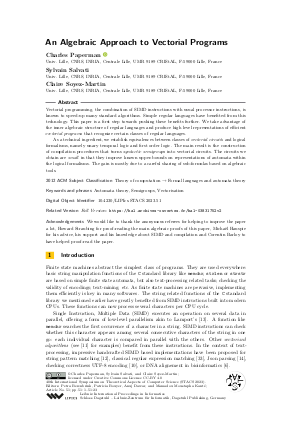@InProceedings{paperman_et_al:LIPIcs.STACS.2023.51,
author = {Paperman, Charles and Salvati, Sylvain and Soyez-Martin, Claire},
title = {{An Algebraic Approach to Vectorial Programs}},
booktitle = {40th International Symposium on Theoretical Aspects of Computer Science (STACS 2023)},
pages = {51:1--51:23},
series = {Leibniz International Proceedings in Informatics (LIPIcs)},
ISBN = {978-3-95977-266-2},
ISSN = {1868-8969},
year = {2023},
volume = {254},
editor = {Berenbrink, Petra and Bouyer, Patricia and Dawar, Anuj and Kant\'{e}, Mamadou Moustapha},
publisher = {Schloss Dagstuhl -- Leibniz-Zentrum f{\"u}r Informatik},
address = {Dagstuhl, Germany},
URL = {https://drops.dagstuhl.de/entities/document/10.4230/LIPIcs.STACS.2023.51},
URN = {urn:nbn:de:0030-drops-177030},
doi = {10.4230/LIPIcs.STACS.2023.51},
annote = {Keywords: Automata theory, Semigroups, Vectorisation}
}

 Creative Commons Attribution 4.0 International license
Creative Commons Attribution 4.0 International license


































